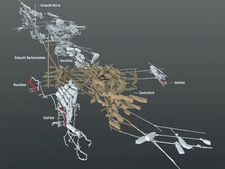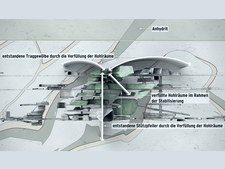Stabilisation of the Morsleben repository
In order to be able to safely operate the Morsleben repository until the nuclear decommissioning procedure concludes with the implementation of the decommissioning measures applied for by the Federal Office for Radiation Protection, the mine openings need to be stable. Neither natural rock movements nor inflowing water must impede the stability. The barrier function of the covering rock layers needs to be kept.
Reason for stabilisation

![]() Central part of the Morsleben repository (yellow)
Central part of the Morsleben repository (yellow)

![]() Stabilised areas in the central part (green; in German only)
Stabilised areas in the central part (green; in German only)
The geomechanical monitoring of the Morsleben repository showed that a damaging process had started in the central part of the Bartensleben mine due to continuous deformations. The reason for this is the very large amount of open drifts in the mine openings and the long life time of the mining cavities which are up to 140,000 cubic metres large.
The central part of the Bartensleben mine is the weak point of the repository. In 2001, a considerable piece of rock salt weighing 5,000 tons got loose from the roof of a chamber and crashed to the ground; later on a small piece of rock crashed from the roof in 2009. Furthermore, mapping works showed a weakening of the roof of a cavity where no radioactive waste has been stored. At this place, too, larger pieces of salt rock weighing up to several thousand tons could have got loose and fallen to the ground.
Because of these damaging processes, the BfS backfilled several mining cavities where no radioactive waste has been stored with salt concrete, thus stabilising the cavities. This was done between October 2003 and February 2011 in the scope of the so-called prevention of mining hazards in the central part (bGZ). Without these backfilling measures it would not have been possible prevent a future failure of load-bearing elements in this area. Salt rock breaking from the roof could have blocked the path to the emplacement chambers and could have put the staff underground at risk.
Stabilisation measures

![]() Supporting effect of the stabilisation measures (in German only)
Supporting effect of the stabilisation measures (in German only)
Altogether 27 mining cavities were backfilled with about 935,000 cubic metres of salt concrete in the course of the stabilisation measures. To be suitable for stabilisation, the salt concrete consisting in particular of rock salt, sand, limestone meal, cement and water, had to meet specific requirements for construction materials. In the scope of quality assurance both the production and the backfilling of salt concrete into the cavities were continuously monitored.
The arrow displays in the above figure indicate the supporting effect that has been achieved by the backfilling in the scope of the bGZ. Two new supporting pillars and two shorter bearing arches have formed, all of which exert lower forces to the surrounding salt rock.
Costs and results of stabilisation
Upon conclusion of the works in February 2011, the costs for the stabilisation measures amounted to 163 million euros. The measures guarantee that the stability of the repository will be kept until the nuclear plan-approval procedure and the implementation of the licensed decommissioning measures conclude.
With backfilling no anticipatory decision has been taken as to the final decommissioning. The pending nuclear decommissioning procedure remains unaffected by the stabilisation works.
State of 2017.01.03

